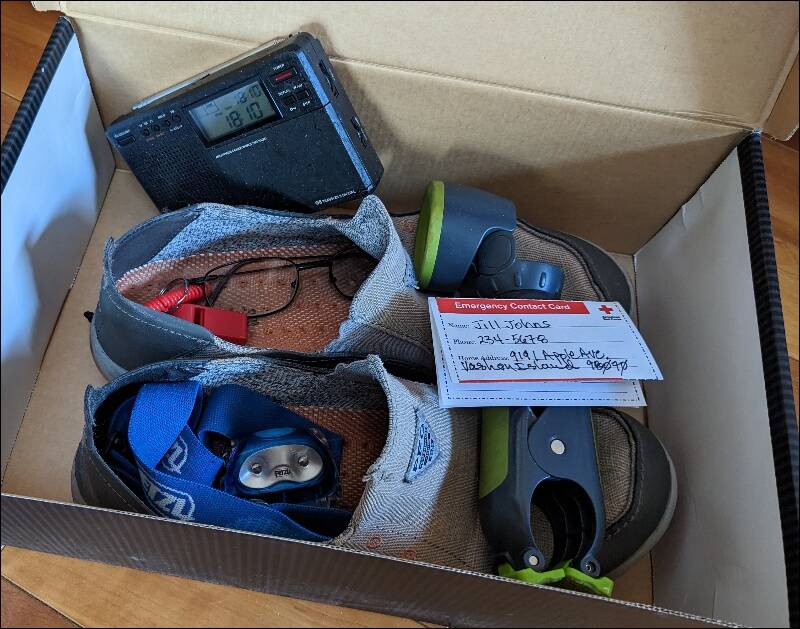The deadly earthquake that struck Japan’s west coast reminds us all that we also live in earthquake country. As promised last week, we focus on household earthquake preparedness in this edition.
Understand Your Hazard: Three Fault Zones
Three major fault zones in our region could produce strong earthquakes like the recent Japanese quake. The Tacoma Fault Zone crosses Vashon Island. The Seattle Fault Zone crosses Puget Sound at Bainbridge Island. A magnitude 9 quake on the Cascadia Subduction Zone 170 miles to our west could produce magnitude 7 shaking here.
Mindset: Long Haul, No Warning
- Prepare for a Long Haul: Generally, the readiness tips for an earthquake are similar to those for a big storm — except you need to think bigger and be prepared for a weeks-long wait for help. Relief agencies will prioritize big population centers where millions may need assistance over areas with small populations, such as Vashon. You need to be prepared to provide your own food, water, and medicine for at least two (we recommend three) weeks in case ferries don’t run and supply lines are cut.
- You Get No Warning: Weather forecasters gave us more than a week’s notice to get ready for our latest winter storm. Earthquakes, however, cannot be predicted. To help you get motivated, pretend you just got a forecast of a major earthquake. What do you need to do to be ready? Start with the tips in this newsletter.
Four Primary Readiness Steps
- Make a Plan: Call a household meeting to think through how you will respond to a disaster, stay informed, and contact each other. Where and how will you reconnect if separated? Sometimes phones won’t connect locally but will work to call or text outside a disaster area. So designate an out-of-state contact that everyone agrees to pass messages through. Set up emergency contacts on your cell phone and keep a paper copy. Practice the plan annually, maybe on a birthday or other family occasion. Here’s a link to an easy-to-use sheet for collecting information at your family planning session.
- Build an Emergency Kit: There are dozens of checklists available online for building emergency kits of all sizes. To get you started, here’s a checklist from King County Office of Emergency Management’s “Make It Through” campaign.
Keep in mind that you need to plan for the long haul. Most household emergency supply lists are designed for communities where you’d be able to drive to a grocery store, even after a bad earthquake. But we’re a ferry-only island. Outside help could be a long time coming. Aim to get by for three weeks after a catastrophic disaster, such as a major earthquake.
Stay Informed
In a disaster, you will need to stay informed about what’s happening and to get helpful advice. Reliable information will help you stay safe and comfortable. Plus, access to trusted sources to learn what’s really happening will help you sift out rumors and misinformation.
Bookmark VashonBePrepared’s website at VashonBePrepared.org. This will be a source of official information if Vashon Island Fire & Rescue activates the Vashon Emergency Operations Center and other teams of volunteers.
Sign up for Voice of Vashon Emergency Alert emails at VoiceOfVashon.org. You can also listen to alerts on 1650AM (keep a battery, wind-up, or solar-powered radio in your kit) or stream them at VoiceOfVashon.org.
Go to your Apple or Android app store, search for the ShakeAlert app and install it on your smartphone. The technology is still new, but you might get vital seconds of warning before earthquake shaking starts to drop, cover, and hold on.
Get Involved
Get hands-on by working as a volunteer with one of our VashonBePrepared coalition teams — Emergency Operations Center (EOC), Community Emergency Response Team (CERT), Marine Emergency Response Team (MERT), Medical Reserve Corps (MRC), or Auxiliary Communications Service (ACS). You can go to this page to get started.
Common-Sense Respiratory Virus Safety Measures
We remain in the winter respiratory virus season. Fortunately, the basic common-sense steps we learned to take at the height of the COVID pandemic also work well during the current respiratory virus season to help prevent spread of RSV and flu.
- Get vaccinated. There are updated vaccines for COVID, flu, and RSV. Getting vaccinated is one of the most effective things you can do to keep yourself from getting really sick from these viruses.
- Wearing a mask significantly reduces the chances of getting COVID, flu, or RSV.
- If you are at higher risk, avoid indoor crowds. Infected people exhale infected air and that could infect you. The more people who are present, the higher the risk that someone has COVID, flu, or RSV, and could pass it on to you.
- If you decide to host an indoor event, improve the air quality by running air purifiers and/or opening nearby windows.
- Be extra vigilant if you are susceptible because your immune system is weakened or you have other risk factors.
- Avoid exposure to people who are sick. If you have symptoms, don’t expose others. Stay home until your fever is gone and you are feeling substantially better.
- Test for COVID with a home test when cold symptoms appear, and again 48 hours later. If you test positive, isolate for at least five days and until you test negative. If you test positive and are at higher risk, talk to your healthcare provider or pharmacist about taking Paxlovid. The medication is most effective in the days immediately following infection.


